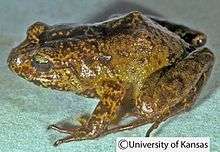Lynchius
Lynchius is a small genus of frogs in the family Craugastoridae.[2] The name honours herpetologist John D. Lynch.[1] The distribution of Lynchius is restricted to the Cordillera Oriental in southern Ecuador and Cordillera de Huancabamba in northern Peru.[2]
| Lynchius | |
|---|---|
 | |
| Lynchius flavomaculatus | |
| Scientific classification | |
| Kingdom: | Animalia |
| Phylum: | Chordata |
| Class: | Amphibia |
| Order: | Anura |
| Family: | Craugastoridae |
| Subfamily: | Holoadeninae |
| Genus: | Lynchius Hedges, Duellman, and Heinicke, 2008[1] |
| Type species | |
| Phrynopus parkeri Lynch, 1975 | |
| Diversity | |
| 6 species (see text) | |
Taxonomy
The placement of Lynchius in Craugastoridae is a new arrangement[3] and many earlier accounts put it in the subfamily Strabomantinae, family Strabomantidae.[4][5][6] The genus itself is relatively new too: it was split off from Phrynopus in 2008 in order to resolve the paraphyly of that genus.[7] The sister taxon of Lynchius is Oreobates.[2]
Description
Lynchius are relatively small frogs (snout–vent length up to 43 mm (1.7 in) in Lynchius flavomaculatus) with a narrow head, not as wide as body. Skin is smooth.[1]
Species
There are seven species in this genus:[2][6]
- Lynchius flavomaculatus (Parker, 1938)
- Lynchius megacephalus Sánchez-Nivicela, Urgilés, Navarrete, Yánez-Muñoz, and Ron, 2019
- Lynchius nebulanastes (Cannatella, 1984)
- Lynchius oblitus Motta, Chaparro, Pombal, Guayasamin, De la Riva, and Padial, 2016
- Lynchius parkeri (Lynch, 1975)
- Lynchius simmonsi (Lynch, 1974)
- Lynchius tabaconas Motta, Chaparro, Pombal, Guayasamin, De la Riva, and Padial, 2016
References
- Hedges, S. B.; Duellman, W. E. & Heinicke, M. P. (2008). "New World direct-developing frogs (Anura: Terrarana): Molecular phylogeny, classification, biogeography, and conservation" (PDF). Zootaxa. 1737: 1–182.
- Frost, Darrel R. (2017). "Lynchius Hedges, Duellman, and Heinicke, 2008". Amphibian Species of the World: an Online Reference. Version 6.0. American Museum of Natural History. Retrieved 21 October 2017.
- Padial, J. M.; Grant, T. & Frost, D. R. (2014). "Molecular systematics of terraranas (Anura: Brachycephaloidea) with an assessment of the effects of alignment and optimality criteria". Zootaxa. 3825: 1–132. doi:10.11646/zootaxa.3825.1.1. PMID 24989881.
- Blackburn, D.C.; Wake, D.B. (2011). "Class Amphibia Gray, 1825. In: Zhang, Z.-Q. (Ed.) Animal biodiversity: An outline of higher-level classification and survey of taxonomic richness" (PDF). Zootaxa. 3148: 39–55.
- Vitt, Laurie J.; Caldwell, Janalee P. (2014). Herpetology: An Introductory Biology of Amphibians and Reptiles (4th ed.). Academic Press. p. 501.
- "Strabomantidae". AmphibiaWeb: Information on amphibian biology and conservation. [web application]. Berkeley, California: AmphibiaWeb. 2017. Retrieved 21 October 2017.
- Frost, Darrel R. (2014). "Phrynopus Peters, 1873". Amphibian Species of the World: an Online Reference. Version 6.0. American Museum of Natural History. Retrieved 5 July 2014.